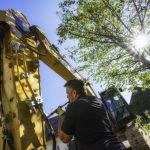Being proactive in catching landscape health concerns at their early stages is crucial.
The Landscape Health Assessment
The first step of a development plan is a landscape health assessment. We conduct a full walkthrough of the area defined by the owner or property manager. During this walkthrough, we analyze the health of all plants. We do not just analyze specific plants themselves, but also the interrelationship of all landscape elements and how they are affecting each other.

We then complete any diagnostic work needed before producing a final report based on the landscape health assessment. This report contains a detailed description of the health of all aspects of your landscape. We provide you with information on areas of concern, their importance and how the issue may be treated.
You may be wondering what the necessity or value is in conducting a landscape health assessment. It’s all about being proactive in catching health concerns at their early stages before things get out of control. You can then avoid more costly remediation efforts down the line or even the loss of tree and its value. Something to consider when debating whether to get an assessment is weighing the cost of it against the cost of replacement, along with the affect a loss would have on your property value.
Get a Greener, Healthier Yard – Contact Us Now
From the Assessment to the Plan
After you receive your landscape health assessment, we can then move forward in creating a management and development plan for the landscape in question. We begin by establishing what the end objective is for the landscape as it matures.
The next consideration is the annual budget for all maintenance and development needs of the landscape. Then comes the creation of an annual or multi-year plan that is aimed at achieving the end objective while working within the allotted budget. Our approach to property management and development starts with the owner’s request for identified work to be done (the basics and the wish list). It is then our responsibility to fit the maintenance and development program of all plants within the budget. With the information we gain from the landscape health assessment, we can prioritize any health issues that need to be remediated as well.
We provide an annual maintenance plan and can also provide a multi-year plan that could include tree planting, tree maintenance, formative plant care, disease and insect control and plant fertilization. A multi-year program that encompasses a gradual development process can help to spread out the growth of your landscape over several years in efforts to accommodate your budget.
From the Plan to the Execution
Now comes the actual execution of the landscape development and management plan. We can offer a range of services from semi-annual visits, to weekly or bi-weekly maintenance, to full management services.
With our landscape management services, we are able to act as your single point of contact for all of your needs. With our landscape management program, we can take full control of all aspects of your landscape, from small plants to the largest of trees.
While there are some services we don’t perform ourselves, our experience as a reputable landscape management company means we can contract with the best external companies in the Collingwood area to achieve your goals. We’ll oversee the work they do on your property so as to avoid unnecessary overlap between services. With our knowledge of landscape best practices, we can save you money and time in the long-term with proper selection, planting, establishment and maintenance techniques. You’ll enjoy fewer costs associated with plant replacement and/or loss of aesthetic value while seeing your landscape truly blossom.
At WillowStone, we offer our clients short-term, long-term, and multi-year programs that can encompass gradual re-plants and landscape development as needed. Our technical approach to your landscape management needs will ensure that you achieve your goals within your budget.
Contact WillowStone Today!
FAQs About Landscape Development Plans
Creating a thriving landscape is a gradual process that requires a holistic, long-term vision. Every plant, pathway, and feature should be chosen with purpose, placed with care, and maintained with consistency. A structured landscape development plan makes that possible by outlining how your property will evolve in a thoughtful, organized way that works with your budget and timeline. These FAQs explain the benefits of using structured development plans and how they help bring your dream landscape to life.
Hidden
How do landscape development plans work?
A landscape development plan breaks your vision into manageable phases that build on one another. It outlines what will be planted, when it will be installed, and how it will be cared for, ensuring a cohesive design that matures over time. The plan also factors in growth rates, seasonal conditions, and how each plant or feature will interact with its surroundings. This step-by-step approach makes it easier to manage costs, maintain quality, and achieve lasting results.
Why spread work over time?
Spreading the work over months or years allows for more precise planning, better plant establishment, and ongoing adjustments as the landscape develops. It prevents overwhelming your budget or resources and ensures each new element receives proper care before moving on to the next stage. This method also allows you to see how your space changes through the seasons and make informed decisions about future additions.
What does a typical plan include?
A typical plan includes plant selection, site preparation, installation schedules, maintenance routines, irrigation planning, and pest or disease prevention. It may also address soil improvement, hardscaping elements, and strategies for enhancing both visual appeal and long-term plant health. By planning ahead, you create a landscape that not only looks great today but also thrives for years to come.
Contact WillowStone Today!
At WillowStone, we provide landscape development plans for residents of Collingwood, The Blue Mountains, Wasaga Beach, Meaford, and Thornbury, Ontario.

